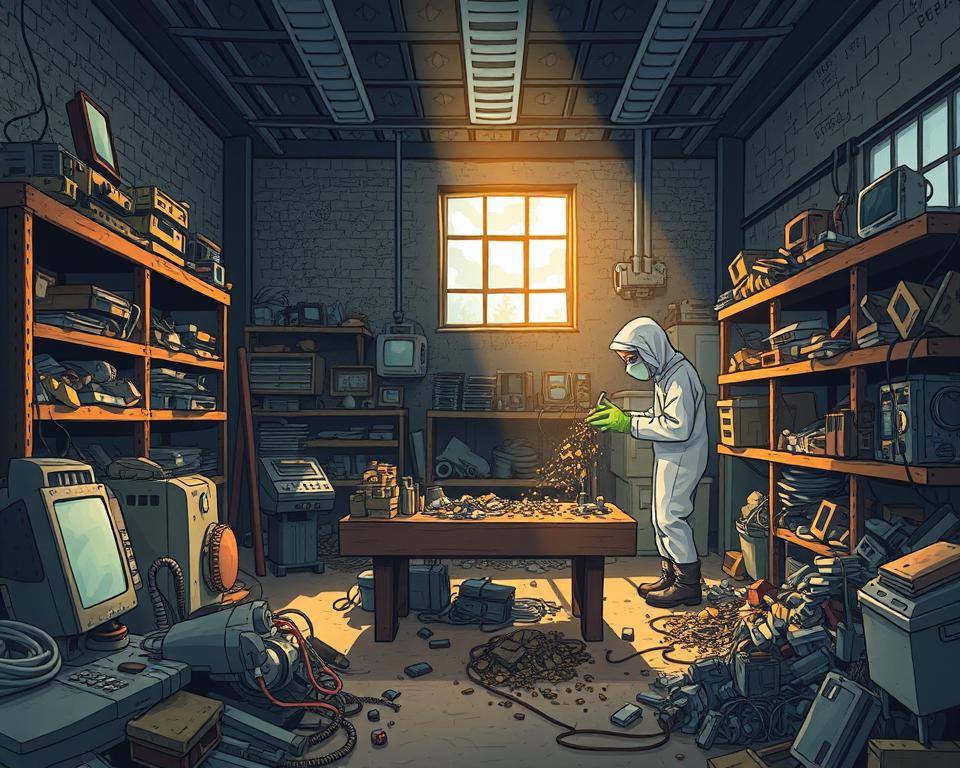Eco-Friendly Precious Metal Recovery Handbook
Did you know that more than $60 billion worth of precious metals are discarded each year in electronic waste alone? That eye-opening statistic shows how important recycling these metals really is. Recycling these metals benefits both the economy and the planet. When we recover gold, silver, platinum, and palladium, we reduce pollution and conserve resources.
Leaders such as Dongsheng Metal Trading are paving the way for sustainable recycling. They guarantee that valuable metals return to use instead of filling dumps. This precious metal recycler approach is key to eco-friendly recycling and sustainable practices.
Major Findings
- Over $60 billion in precious metals is disposed of in electronic waste annually.
- Recycling precious metals shrinks environmental harm and saves resources.
- Gold, silver, platinum, and palladium top the list of valuable metals.
- Sustainable development depends on eco-friendly recycling.
- Firms such as Dongsheng Metal Trading focus on precious metal recovery.
Understanding Precious Metals and Their Value
Precious metals are rare, naturally occurring metallic elements that have captured the interest of investors and industries alike. Gold, silver, platinum, and palladium stand out for their distinct qualities. Notable traits are excellent conductivity, corrosion resistance, and rarity. Extracting and refining them uses up huge resources, so recycling becomes critical.

The value of precious metals is influenced by market demand and the inherent qualities of each metal. Recovering metals is key to keeping the supply chain alive. It lowers the ecological damage from mining. By thorough recycling, these metals return to their pure form. Such efforts save limited resources and create economic gains.
Defining Precious Metals
Unique features make precious metals ideal for many uses. Their rarity and intrinsic properties are foundational to their economic significance. Key examples include:
- Gold: Admired for its luster and low corrosion.
- Ag: Known for flexible uses and excellent conductivity.
- Pt: Esteemed for its toughness and catalyst role.
- Palladium: Gaining traction in cars and electronics.
Why Recycle Precious Metals?
Recycling these metals is now key to sustainable practices. It saves scarce materials and sharply cuts mining’s eco-footprint. Consider these advantages:
- Lessening of habitat destruction from mining.
- Using far less energy than fresh extraction.
- Feeding materials back into the production loop.
- Opportunity for profit by recovering valuable metals.
The Importance of Precious Metal Recycling
Metal recycling brings both green and economic gains. Emphasizing benefits helps cut environmental harm. Plus, it spurs economic development and steadiness.
Environmental Benefits
The environmental benefits of recycling precious metals are significant. Retrieving metals from scrap and electronics reduces landfill load. This reduces the need for new mining, conserving natural resources.
This approach minimizes the harmful effects of mining, such as habitat destruction and pollution. Focusing on recycling precious metals helps us strive for a more sustainable future.
Economic Benefits
Economic upsides of recycling stand out equally. Recovering metals cuts production expenses. That shift enables firms to opt for recycled rather than virgin metals.
It produces recycling-sector employment and strengthens markets with growing recycled-metal needs. Using these financial benefits, companies can improve profits. They further support a cleaner economy.
How Precious Metals are Recycled
Recovering precious metals involves multiple steps for peak efficiency. First, scrap electronics, jewelry, and industrial waste are gathered. They are sorted, decontaminated, and analyzed to gauge composition and value.
Recycling Workflow
This systematic approach is vital for effective metal recovery. All stages focus on boosting metal yield. Sorting separates metals by type and purity. Cleaning removes contaminants that could hinder recovery. Analysis identifies the concentration of precious metals, guiding the choice of recycling techniques.
Recovery Methods
High-tech methods are used to maximize metal retrieval. One method, thermal reduction, leverages heat to separate metals from base materials. Molten refining and wet-chemistry steps handle finer separations. Recyclers like Dongsheng Metal Trading employ these approaches to improve yields and returns.
Recyclable Precious Metals
Recycling is vital for the environment and for recovering valuable materials. Many precious metals can be recycled, benefiting both the economy and the planet. Awareness of recyclable metals guides consumers and companies.
Recycling Gold, Silver & Platinum
Gold, silver, and platinum are well-known precious metals. You’ll see them in rings, currency, and industrial parts. Gold’s high price and use make it a prime recycling target. Silver’s role in cameras, electronics, and solar energy makes its recycling vital.
Platinum, while rarer, finds value in catalytic converters.
E-Waste Metals
Electronic precious metals offer unique recycling chances. Devices such as phones and computers hold palladium and indium. Recovering such metals diminishes e-waste and yields vital materials.
Recycling these electronics metals is imperative. Businesses work to reduce scrap and upscale resource recovery.
Who Gains from Metal Recycling?
Precious metal recycling is essential for several key industries, allowing them to use valuable resources efficiently and sustainably. Device manufacturing in electronics profits hugely from recovered metals. Aerospace and medical sectors also depend on these metals for critical components. Looking at their recycling practices shows green and financial gains.
E-Waste Sector
The electronics industry leads in precious metal recycling due to the abundance of valuable metals in devices like smartphones and computers. Quick device turnover spawns more electronic scrap. Thus, recycling gold, silver, and palladium efficiently becomes vital. That saves resources and cuts mining carbon footprints.
Companies are increasingly focusing on recycling to meet global sustainability and waste reduction goals. That change bolsters resource saving and ecosafety.
Aerospace & Medical
Metal recovery is key in aerospace and medical sectors where metals are in vital parts. High-performance alloys are essential for manufacturing flight parts and medical devices due to their durability and resistance to corrosion. Recovering them cuts costs and meets green regulations.
These sectors know green recovery eases resource shortages. It also enhances operational efficiency, making recycling a key strategy for sustainability.
Finding Precious Metal Recycling Companies
Locating reliable recycling partners ensures great results. You should probe their procedures thoroughly. Their fees and techniques will shape your outcome. By comparing services, you can see what each company offers and make a smart choice.
Questions to Ask Recycling Companies
- Which recovery certifications does your company have?
- Can you explain your processing methods for different metals?
- What are your recovery rates for various precious metals?
- What is your pricing structure and are there extra charges?
- Can you share feedback from past customers?
Service & Price Comparison
You must evaluate services side-by-side to pick the right recycler. Use a table to line up these factors:
| Company Name | Recovery Rate (%) | Processing Fee ($) | Turnaround Time (Days) |
|---|---|---|---|
| Recycling Co. A | 95 | 50 | 7 |
| Recycling Co. B | 90 | 45 | 5 |
| Recycling Co. C | 92 | 55 | 10 |
By comparing recycling services, you can find the best recycler for your needs. This ensures you get the most value and meet industry standards.
Precious Metal Recycling: Your Eco-Friendly Guide
Knowing recycler operations matters if you recycle metals. These experts manage the entire process, from collection to processing. That approach drives top efficiency and returns.
How Recyclers Operate
Recyclers use advanced methods for metal recycling, including testing, separation, and refining. They start by collecting metal scraps from various sources. Then, they use sophisticated techniques to separate different metals. Next, they refine these metals to extract precious elements like gold, silver, and platinum.
That workflow both boosts recovery and promotes green methods. It’s fundamental to building a sustainable future.
Choosing the Right Recycler for Your Needs
You’ll want to weigh several factors in your choice. Begin by checking their green credentials. In today’s market, a commitment to sustainability is essential. Also, examine if they handle everything or only certain stages.
Pricing is another key factor. Gather price quotes for side-by-side comparisons. Firms such as Dongsheng Metal Trading tailor services to each sector. They remain a trusted partner for targeted recovery.
Pick the Right Facility
Metal recycling is a critical sector for sustainable practices and waste management. Multiple types of facilities handle various recycling demands. Awareness of facility types guides you to proper recyclers. This benefits both businesses and the environment.
Facility Categories
There’s a broad spectrum of recycling operations. Some yards recover gold and silver; others accept all metal waste. Common examples include:
- Scrap yards process a broad mix of metal types.
- Specialized firms recover gold, silver, and platinum with advanced refining.
- E-Waste Recycling Centers: Specialize in recovering metals from discarded electronics, capitalizing on the valuable components often found in these devices.
Location and Access to Facilities
Proximity to recyclers cuts logistical hurdles. Companies should evaluate haulage considerations. Key access factors include:
| Factor | Description |
|---|---|
| Proximity | Facilities located nearer to businesses minimize transportation costs and time. |
| Partnerships | Having established relationships with local recyclers can enhance efficiency in recycling processes. |
| Services Offered | Awareness of service menus aids in picking the right center. |
Choosing appropriate centers and easy access drives recovery efficiency.
Electronic Waste Recycling and Precious Metals
E-waste poses a major ecological challenge. Discarded devices often contain precious metals that can be recovered through recycling. This highlights the importance of seeing e-waste as a valuable resource.
How Electronics Contain Precious Metals
Gadgets harbor small quantities of precious metals. These metals are found in various parts:
- Circuit boards
- Connectors and ports
- Capacitors and resistors
- Battery terminals
Common electronics conceal recoverable metals. With recycling, we can efficiently recover and reuse them.
E-Waste Recovery Benefits
Recycling electronics protects nature and recovers resources. It trims dump loads and conserves raw materials. The benefits of recycling e-waste metals are clear:
- It minimizes environmental risks from improper disposal
- It reduces CO₂ output via green recycling methods
- It fuels a circular economy by feeding materials back into manufacturing
Championing electronics recycling fosters responsible resource use. It lays the groundwork for a greener future.
What’s Next in Metal Recycling?
Metal recycling is evolving, spurred by tech advances and green initiatives. With resource conservation rising, recyclers are innovating. By integrating novel processes, they pave the way forward.
Eco-Friendly Recycling Innovations
Modern green recycling strives to cut waste and eco-damage. Businesses adopt green packaging and energy-saving techniques. That evolution supports global green targets and fosters industry responsibility.
Cutting-Edge Recovery Methods
Advances in recovery techniques are key to improving precious metal recycling efficiency. New technologies, such as automated sorting and hydrometallurgical extraction, enhance recovery rates. These innovations not only increase resource extraction but also reduce environmental impact, marking a significant step forward in recycling precious metals.
Starting a Precious Metal Recycling Venture
Launching a metal recovery firm requires careful strategy and market insight. Entrepreneurs must outline key steps to build a strong foundation and adhere to industry regulations. This includes conducting extensive market research and identifying target clients. Securing licenses and legal compliance is crucial for long-term viability.
Launching Steps
To launch your recycling venture, follow these steps:
- Analyze market demand and competitor landscape.
- Draft a strategy blueprint covering targets and methods.
- Acquire suitable recycling equipment that meets your operational needs.
- Obtain capital via loans or investors.
- Secure regulatory approvals and certifications.
- Deploy promotional plans to gain customers.
Legal Considerations and Certifications
Understanding legal aspects when starting a precious metal recycling business is critical. Meeting environmental rules protects your operation and the planet. Must-know compliance points:
- Securing business certification from relevant authorities.
- Ensuring full compliance with disposal and recycling laws.
- Certifying employee knowledge of safety and handling rules.
In Closing
Precious metal recycling is essential for preserving natural resources and improving environmental health. It helps people and companies cut waste’s ecological toll. That reclaimed metal cuts mining demand and spawns recycling jobs.
Beyond green gains, recycling yields financial perks. Working with Dongsheng Metal Trading guarantees green standards. That partnership bolsters circular models for recyclers and buyers alike.
The journey to a sustainable future depends on collective action in recycling precious metals. Raising awareness fosters mindful use and eco stewardship. Implementing these measures supports us today and safeguards future generations.

